Explore Yangshuo - China Travel, Asia
Nestled in the heart of Guangxi Province, Yangshuo is China’s hidden gem waiting to be discovered. Known for its dramatic karst mountains, serene rivers, and vibrant local culture, Yangshuo offers a unique blend of natural beauty and traditional charm. Whether you're an adventure seeker or a cultural enthusiast, Yangshuo has something for everyone. Let’s travel to Guangxi Province and explore the best of what Yangshuo has to offer.
Population: Approximately 300,000 in 2020.
Economy: Yangshuo’s economy thrives on tourism, agriculture, and local crafts, with tourism driving growth through its stunning landscapes and cultural attractions.
Landmarks: Famous for the Li River, Moon Hill, Yulong River and Silver Cave.
China
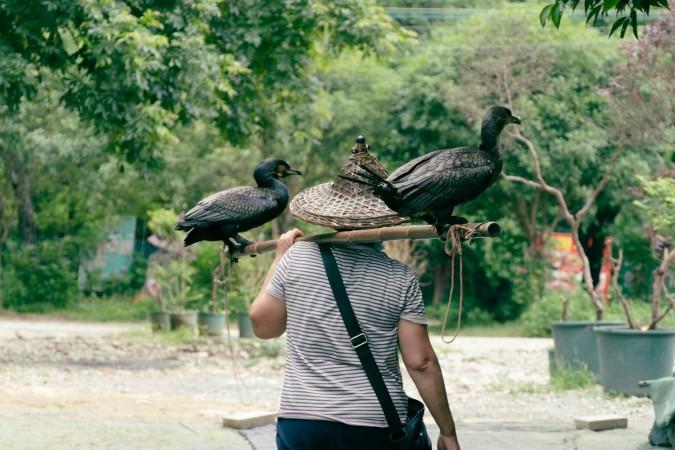
Overview of Yangshuo
History & Cultural Influence
Yangshuo's history dates back thousands of years, reflecting a tapestry of rich cultural influences. Originally a small fishing village, it has grown into a beloved tourist destination without losing its traditional charm. The town's heritage is showcased in its architecture, local customs, and historical landmarks. One of the most captivating aspects of Yangshuo is its fusion of traditional Chinese culture with modern tourism. Visitors can explore historical sites and enjoy cultural performances, such as the famous "Impression Liu Sanjie" show, which depicts local folklore against the backdrop of the Li River.
Interaction with the Locals
Yangshuo, a picturesque town in Guangxi Province, has a population of around 300,000 people. The residents, known for their friendliness and hospitality, are predominantly Han Chinese, with a significant number of ethnic minorities such as the Zhuang, Yao, and Miao. The citizens of Yangshuo maintain a strong connection to their traditional customs and way of life, while also embracing the town's growing popularity as a tourist destination. This blend of old and new makes Yangshuo a vibrant and welcoming place for visitors.
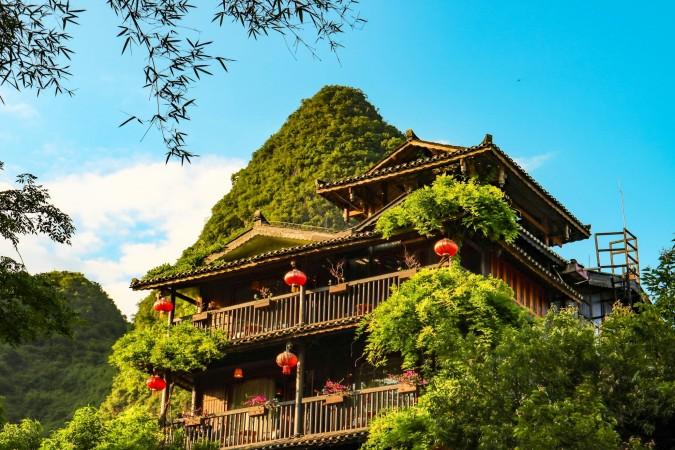
Yangshuo ancient architecture - © Kurt z
Top Attractions in Yangshuo
Li River
The Li River is the centerpiece of Yangshuo's natural allure. Known for its enchanting karst landscape, a cruise along the Li River offers one of China’s most iconic views. The river winds through towering limestone peaks and lush green countryside, providing a serene and picturesque experience. The journey typically starts in Guilin and concludes in Yangshuo, featuring highlights like the Elephant Trunk Hill and the Nine Horses Fresco Hill. A bamboo raft ride on the river also offers a more intimate way to experience the stunning scenery.
Moon Hill
Moon Hill, a striking natural arch with a crescent-shaped hole, is a must-see for those who enjoy hiking and panoramic views. The arch rises 380 meters above the ground and is framed by a unique limestone formation. The climb to the top is a rewarding experience, offering sweeping views of the surrounding countryside and the Li River. Moon Hill hiking trails, though challenging, are manageable and provide ample opportunities for photography and appreciating the natural beauty of Yangshuo.
Yulong River
The Yulong River, often referred to as the "Little Li River," offers a more tranquil alternative to its famous counterpart. This meandering river is perfect for a relaxing bamboo raft ride, where you can drift past picturesque rice paddies and charming rural landscapes. The gentle flow and stunning scenery provide a peaceful retreat from the bustling town center. The surrounding countryside is also ideal for cycling, with scenic routes that offer views of traditional villages and lush green fields.
Silver Cave
Silver Cave, also known as Yinzi Cave, is a captivating subterranean wonder. This extensive karst cave system features impressive stalactites, stalagmites, and unique rock formations that resemble silver ornaments. The cave is illuminated with colorful lights, enhancing the natural beauty of the formations. The exploration of Silver Cave provides a fascinating glimpse into the underground world, making it a popular destination for adventure enthusiasts and geology lovers alike.
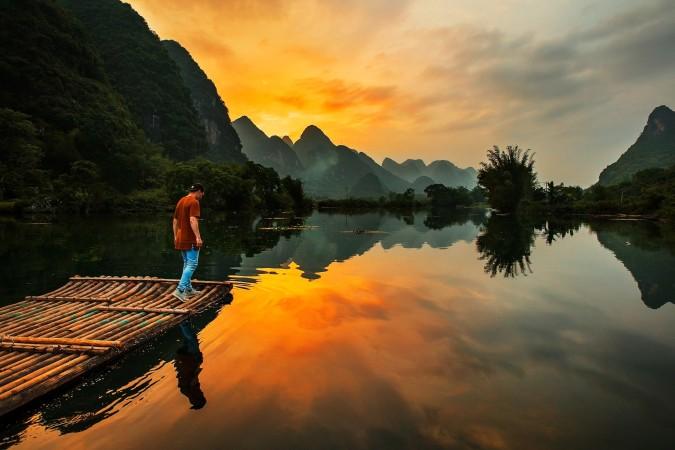
Yulong River - © Joshua Earle
Must-Try Dishes in Yangshuo
Yangshuo’s culinary offerings are as diverse as its landscape. The local cuisine is characterized by fresh ingredients, bold flavors, and unique preparation methods.
- Beer Fish: A local favorite, Beer Fish is a flavorful dish where fish is cooked in a savory beer-based sauce, infused with garlic, ginger, and a mix of vegetables. The beer imparts a distinctive taste, making it a unique and delicious experience.
- Li River Snails: A daring choice for adventurous eaters, Li River Snails are cooked with aromatic spices and herbs, creating a spicy and flavorful dish. The snails are tender and absorb the rich spices, making for a memorable culinary experience.
- Pork Belly with Preserved Vegetables: This dish features succulent pork belly slow-cooked with preserved vegetables, creating a rich, savory flavor. The combination of tender pork and tangy preserved vegetables is both hearty and comforting.
- Bamboo Rice: Bamboo Rice is rice cooked inside bamboo tubes, which imparts a subtle smoky flavor. Often combined with mushrooms or nuts, this dish is aromatic and flavorful, offering a unique taste of local cuisine.
- Yao Yao Rice: A traditional Yao dish, Yao Yao Rice is cooked with a variety of ingredients such as salted pork, mushrooms, and pickled vegetables. The rice is flavored with the rich tastes of the accompanying ingredients, resulting in a hearty and satisfying meal.
- Yangshuo Cold Noodles: Ideal for hot days, Yangshuo Cold Noodles are served chilled and dressed in a tangy sauce made from soy sauce, vinegar, and sesame paste. Garnished with fresh vegetables and herbs, these noodles are refreshing and flavorful.
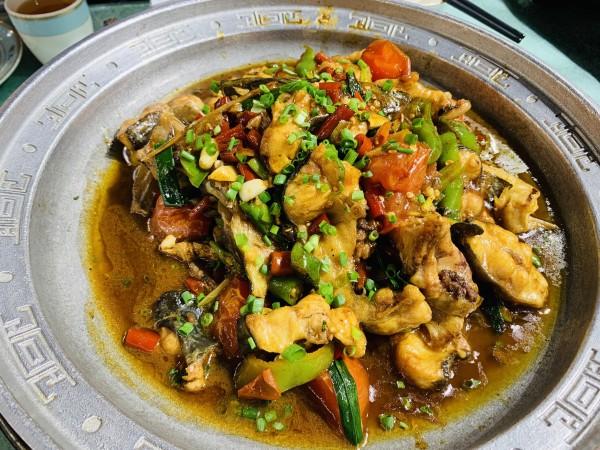
Yangshuo Beer Fish - © Chinese Foods
Festivals & Local Celebrations
Yangshuo's vibrant festivals and local celebrations offer a fascinating glimpse into the region’s culture and traditions. These events are marked by colorful festivities, traditional performances, and local rituals.
Yangshuo Lantern Festival
Held during the Lantern Festival, which falls on the 15th day of the Chinese New Year, this celebration lights up Yangshuo with beautifully crafted lanterns. The festival features lantern displays in various shapes and sizes, traditional lion dances, and cultural performances. It’s a joyous occasion that brings the community together to celebrate the end of the lunar new year festivities.
Yangshuo International Tourism Festival
The Yangshuo International Tourism Festival is an annual event that celebrates the town’s status as a popular tourist destination. The festival includes a variety of activities such as folk performances, art exhibitions, and international food stalls. It’s an opportunity for visitors to experience both local culture and global influences in a festive setting.
Dragon Boat Festival (Duanwu Festival)
Celebrated on the 5th day of the 5th lunar month, the Dragon Boat Festival features exciting dragon boat races on the Li River. Participants compete in traditional wooden boats, decorated with colorful dragon heads. The festival also includes eating zongzi, sticky rice dumplings wrapped in bamboo leaves, and various cultural performances.

Duanwu Festival - © CGTN
What to Do in Yangshuo
Yangshuo offers a diverse range of activities that cater to various interests, from adventure seekers to relaxation enthusiasts. These activities provide a range of experiences that showcase Yangshuo’s natural beauty and cultural richness, ensuring that there’s something for everyone to enjoy.
- Li River Bamboo Rafting: Floating gently along the river, you’ll enjoy stunning views of the karst landscape and lush greenery. The peaceful ride allows you to immerse yourself in the natural beauty of the area, making it a relaxing and picturesque experience.
- Yangshuo Countryside Cycling Tours: Cycling is a popular way to explore Yangshuo’s stunning countryside. Ride through scenic routes and pass by the rice paddies, traditional villages, and dramatic limestone peaks. The flat terrain and well-maintained paths make it accessible for cyclists of all levels.
- Rock Climbing in Yangshuo: For thrill-seekers, Yangshuo is renowned for its excellent rock climbing opportunities. The region offers a variety of climbing routes suitable for different skill levels, with routes that provide spectacular views of the surrounding landscape.
- Exploring Caves and Karst Formations: Aside from Silver Cave, Yangshuo features other fascinating caves and karst formations. Visit the Butterfly Spring Cave or the Water Cave for more underground adventures. These natural wonders are adorned with impressive rock formations and provide an exciting exploration experience.
Shopping in Yangshuo
Yangshuo offers a variety of shopping experiences, from bustling markets to unique artisan shops. These shopping places in Yangshuo offer a blend of traditional and modern experiences, making it easy to find memorable souvenirs and unique gifts during your visit.
- West Street: West Street is the central shopping hub of Yangshuo, bustling with activity and filled with a diverse range of shops and stalls. Here, you can find local handicrafts, souvenirs, traditional Chinese artifacts, and trendy boutiques.
- Yangshuo Souvenir Market: Located near the heart of Yangshuo, this market specializes in local souvenirs such as handmade crafts, traditional Chinese decor, and unique gifts. It’s a great place to pick up items like silk scarves, calligraphy scrolls, and bamboo products.
- Li River Market: Located along the Li River, this market offers a selection of local produce, snacks, and artisanal goods. It’s a good spot to purchase fresh fruits, local delicacies, and traditional handicrafts.
- Traditional Handicraft Workshops: Visit local workshops and studios where artisans create traditional handicrafts such as paper umbrellas, embroidered fabrics, and bamboo crafts. Purchasing directly from these workshops allows you to see the craftsmanship firsthand and buy authentic, handmade items.
- Yao Village Craft Market: Located in the nearby Yao Village, this market features crafts and textiles made by the Yao ethnic minority. Here, you can find beautiful embroidery, traditional clothing, and unique handcrafted items that reflect the Yao culture.
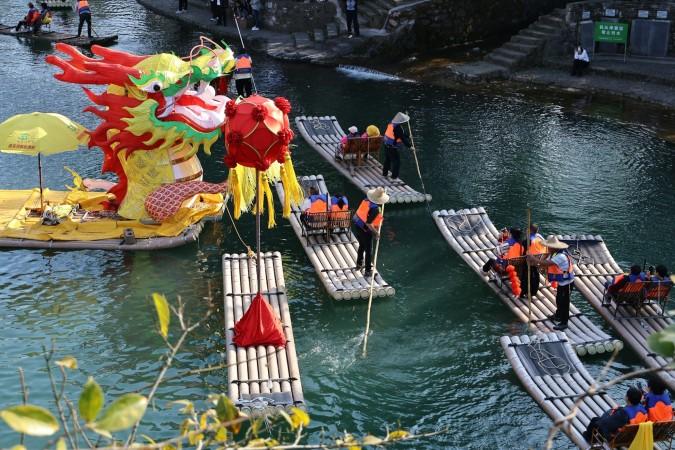
Li River Bamboo Rafting - © Vickee Poon
Weather in Yangshuo: Best Time to Visit
Yangshuo’s weather is a key factor in planning your visit. The region experiences a subtropical climate with distinct seasons.
Spring in Yangshuo
Spring in Yangshuo is mild and pleasant, with temperatures ranging from 15°C to 25°C (59°F to 77°F). This is an ideal time to visit, as the weather is comfortable and the countryside bursts into vibrant colors with blooming flowers. It's a great season for outdoor activities like hiking and cycling.
Summer in Yangshuo
Summer in Yangshuo can be hot and humid, with temperatures reaching up to 35°C (95°F). The region also experiences frequent rainfall during this season, contributing to the lush greenery of the landscape. While the weather can be warm, it’s also the time for lush landscapes and vibrant festivals.
Autumn in Yangshuo
Autumn offers cooler temperatures and lower humidity, making it a fantastic time to visit for outdoor activities and sightseeings. The range of temperatures is 15°C to 28°C (59°F to 82°F). The countryside is still lush and picturesque, and the weather is usually clear.
Winter in Yangshuo
In comparison to other parts of China, Yangshuo experiences a warm winter, with average highs of 8°C to 15°C (46°F to 59°F). It’s relatively dry, though occasional chilly days and light frost can occur. This is a quieter time for tourism, providing a more relaxed atmosphere.
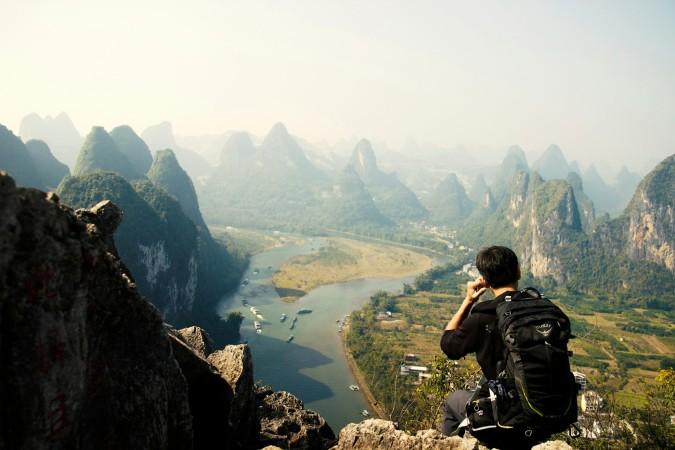
Spring in Yangshuo is the best time for hiking - © Daniel Höhe
Culture Etiquette in Yangshuo
Embracing local customs and etiquette can enhance your experience in Yangshuo. Understanding and respecting these local customs will help you enjoy a more immersive and respectful experience in Yangshuo, fostering positive interactions with the community.
- Respecting Local Traditions: In Yangshuo, traditional customs play a significant role in daily life. When visiting rural areas or participating in local festivals, dress modestly and be mindful of cultural practices.
- Greeting Etiquette: When meeting locals, a friendly handshake is appropriate. For elders or those in positions of respect, a slight bow is a sign of honor. In rural settings, a warm smile and a nod can go a long way in showing respect and friendliness.
- Dining Practices: Dining etiquette in Yangshuo reflects broader Chinese customs. Meals are often served family-style, with dishes shared among everyone at the table. Use the provided serving utensils to transfer food to your plate and avoid sticking chopsticks upright in your rice bowl, as this resembles a funeral ritual.
- Gift Giving: If you are invited to someone’s home or attending a local celebration, bringing a small gift is a thoughtful gesture. Common gifts include fruit, tea, or local handicrafts. Give gifts with both hands to show respect, and no matter how little the gift, remember to be grateful for whatever you get.
- Handling Transactions: When shopping or negotiating in markets, it’s customary to be polite and friendly. Haggling is acceptable in some local markets, but always do so with a smile and in a respectful manner.
Essential Travel Information
Getting Around Yangshuo
- Bicycles and E-Bikes: Bicycles and e-bikes are popular and convenient ways to explore Yangshuo. Cycling allows you to enjoy the scenic countryside at your own pace.
- Taxis and Ride-Sharing: Taxis are available in Yangshuo, and ride-sharing apps like Didi can be used for convenient travel within the town and to nearby attractions. Ensure you have your destination written in Chinese to avoid communication issues.
- Local Buses: Local buses are an economical option for traveling within Yangshuo and to nearby areas. Buses are generally reliable, but schedules may vary, so it's best to check local timetables.
- Bamboo Rafts: For a unique experience, consider taking a bamboo raft ride on the Li River or Yulong River. It’s a scenic way to see the landscape and a popular activity for visitors.
- Car Rentals: If you prefer driving, renting a car is an option. Be aware that road conditions and traffic rules may differ from what you're used to, and navigating rural roads can be challenging.
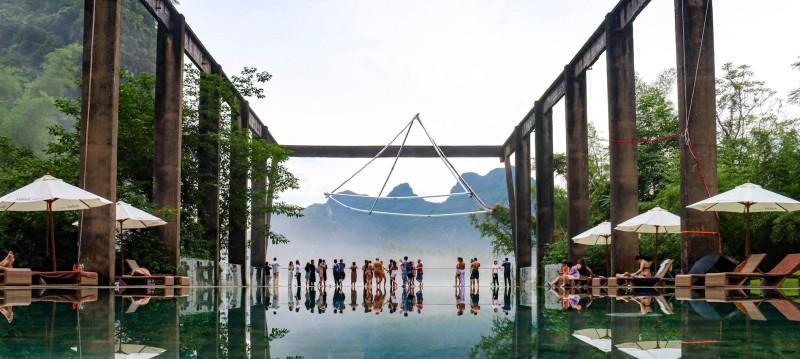
Sugar Factory resort - © Kurt z
ATM & Banking Services
Yangshuo provides various options for managing your financial needs. ATMs are conveniently located throughout the town, particularly in the center and near major hotels, accepting international credit and debit cards for cash withdrawals, though be mindful of potential transaction fees from your bank. Banking services are also available, with several branches offering currency exchange and other financial services. While major credit cards are widely accepted at hotels, restaurants, and shops, smaller establishments and local markets often prefer cash.
Where to Stay in Yangshuo
Yangshuo offers a diverse range of accommodation options to suit various preferences and budgets. For a luxurious stay, high-end hotels provide world-class amenities, including stunning river views, spa services, and fine dining. Budget-conscious travelers can find affordable hotels and hostels with basic amenities, conveniently located for exploring the town. Guesthouses, often run by local families, provide a homely feel and may include meals and guided tours.
Articles for you

Explore Yala National Park - Sri Lanka Travel, Asia
Tucked away in Sri Lanka’s southeastern corner, Yala National Park is where wild nature meets deep tradition. Known worldwide for its leopard population, the park is also home to elephants, sloth bears, crocodiles, and hundreds of bird species. Beyond wildlife, Yala opens doors to a cultural landscape dotted with ancient temples, Buddhist ruins, and coastal villages. For travelers seeking more than just a safari, Yala offers a chance to explore eco-tourism, local communities, and sacred heritage sites.
Population: The Yala National Park area doesn’t have a human population.
Economy: The economy around Yala National Park thrives on a blend of eco-tourism, agriculture, and local services. Safari tours, eco-lodges, and cultural experiences drive steady income for nearby towns like Tissamaharama and Kataragama, supporting thousands of families.
Landmarks: Famous for Block I of Yala and wildlife encounters, including elephants, sloth bears, crocodiles, and exotic bird species.

Explore Galle - Sri Lanka Travel, Asia
Nestled on Sri Lanka’s southern coastline, Galle is a vibrant city where history meets the sea. Its cobbled streets, colonial architecture, and serene beaches make it a must-visit destination for travelers seeking a blend of culture, adventure, and relaxation. A UNESCO World Heritage site, Galle captivates visitors with its Dutch Fort, bustling markets, and friendly locals. Whether you’re exploring the ramparts at sunset or savoring fresh seafood by the shore, Galle promises an unforgettable journey into Sri Lanka’s heritage.
Population: Approximately 113,000 in 2023.
Economy: Galle’s economy thrives on tourism, trade, and fisheries. The city’s historic fort, colonial architecture, and coastal charm draw thousands of international visitors each year, making tourism its main economic driver. Fishing remains vital for local livelihoods, supplying fresh seafood across the region.
Landmarks: Famous for the Galle Fort, Dutch Reformed Church & Maritime Museum, and Unawatuna Beach.

Explore Bentota - Sri Lanka Travel, Asia
Nestled along Sri Lanka’s southwestern coast, Bentota is a tropical paradise that blends golden beaches, vibrant culture, and thrilling adventures. Famous for its calm waters, luxury resorts, and scenic river estuary, Bentota has become a top destination for travelers seeking both relaxation and authentic experiences. From serene beach walks at sunrise to adrenaline-pumping water sports, this coastal town offers a perfect balance of leisure and exploration. With its proximity to Colombo and Galle, Bentota is easy to reach, making it an ideal stop for both short escapes and extended holidays.
Population: Approximately 37,000 in 2023.
Economy: Bentota’s economy thrives mainly on tourism, which drives local businesses such as hotels, restaurants, and wellness retreats. The town also benefits from fishing, coconut cultivation, and handicrafts like wood carving and batik textiles. Many residents rely on the growing demand for water sports and Ayurvedic treatments, making tourism the backbone of both income and employment in the area.
Landmarks: Famous for Bentota Beach, Bentota River Safari, and Kande Vihara Temple.

Explore Mirissa - Sri Lanka Travel, Asia
Mirissa is a charming coastal town on Sri Lanka’s southern shoreline. Known for its golden beaches, turquoise waters, and vibrant marine life, it has become a must-visit stop for travelers exploring the island. Many come for whale watching, surfing, and sunset views at Coconut Tree Hill, but Mirissa offers much more than postcard beauty. The fishing boats you see anchored by the bay carry generations of stories. Local traditions, delicious cuisine, and a laid-back rhythm of life shape every visitor’s experience.
Population: Approximately 4,700 in 2023.
Economy: Mirissa’s economy is largely shaped by its coastal location. Fishing has long been the backbone of local livelihoods, with generations relying on the Indian Ocean for income. In recent decades, tourism has become the main driver of growth, thanks to whale watching, surfing, and beachside hospitality.
Landmarks: Famous for Mirissa Beach, Coconut Tree Hill, and Parrot Rock Bridge.

Explore Nuwara Eliya - Sri Lanka Travel, Asia
Tucked away in the Central Highlands of Sri Lanka, Nuwara Eliya is often called “Little England”. With its rolling tea plantations, cool misty mornings, and colonial charm, this mountain town feels like a step into another world. Travelers come here to breathe fresh air, walk through flower gardens, sip the finest Ceylon Tea, and enjoy a pace of life far from the island’s busy cities. Whether you’re drawn by scenic landscapes, heritage architecture, or the warmth of its people, Nuwara Eliya is a destination that blends nature, culture, and history in perfect harmony.
Population: Approximately 781,000 in 2023.
Economy: Nuwara Eliya’s economy thrives mainly on tea production, as it sits in the heart of Sri Lanka’s central highlands, famous worldwide for Ceylon Tea. The city also benefits from a growing tourism industry, attracting visitors with its colonial charm, cool climate, and scenic landscapes.
Landmarks: Famous for Gregory Lake, Hakgala Botanical Garden, and Victoria Park.

Explore Sukau - Malaysia Travel, Asia
Nestled on the banks of the Kinabatangan River in Sabah, Malaysian Borneo, Sukau is a destination where wildlife, culture, and conservation come together. Known as one of Asia’s top spots for river safaris and eco-tourism, this quiet village offers a front-row seat to encounters with Bornean orangutans, pygmy elephants, proboscis monkeys, and exotic birdlife.
Population: Approximately 1,400 in 2019.
Economy: Sukau’s economy is shaped by its riverine location and natural resources. Traditionally, the Orang Sungai community relied on fishing, small-scale farming, and forest gathering for their livelihood. Today, the village has shifted toward eco-tourism, with river cruises, jungle trekking, and homestays providing income.
Landmarks: Famous for the Kinabatangan River cruises, Gomantong Caves, and Ox-bow lakes and wetlands.
